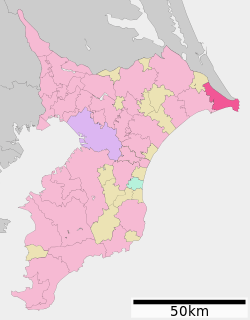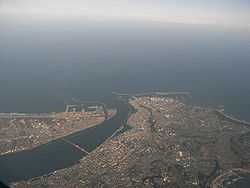Chōshi
| Chōshi 銚子市 | |||
|---|---|---|---|
| City | |||
|
Aerial view of Chōshi | |||
| |||
 Location of Chōshi in Chiba Prefecture | |||
 Chōshi
| |||
| Coordinates: 35°44′N 140°50′E / 35.733°N 140.833°ECoordinates: 35°44′N 140°50′E / 35.733°N 140.833°E | |||
| Country | Japan | ||
| Region | Kanto | ||
| Prefecture | Chiba Prefecture | ||
| Government | |||
| • Mayor | Shinichi Koshikawa (since 17 May 2013) | ||
| Area | |||
| • Total | 83.91 km2 (32.40 sq mi) | ||
| Population (April 2012) | |||
| • Total | 68,197 | ||
| • Density | 813/km2 (2,110/sq mi) | ||
| Time zone | Japan Standard Time (UTC+9) | ||
| - Tree | Sazanka | ||
| - Flower | Ōmatsuyoigusa (Oenothera erythrosepala) | ||
| - Fish | Sardine | ||
| Phone number | 0479-24-8181 | ||
| Address | 1-1 Wakamiyachō, Chōshi-shi, Chiba-ken 288-8601 | ||
| Website |
www | ||
Chōshi (銚子市 Chōshi-shi) is a city in Chiba Prefecture, Japan.
As of April 2012, the city has an estimated population of 68,197 and a population density of 813 persons per km². The total area is 93.91 km2 (36.3 sq mi).
Geography
Chōshi is the easternmost city in the Greater Tokyo Area, and Cape Inubō, within the city, is the easternmost point in the Kantō region. Chōshi is noted for its dramatic sea coast.[1]
Neighboring municipalities
- Asahi, Chiba
- Tōnoshō, Chiba
- Kamisu, Ibaraki
Climate
Chōshi has a humid subtropical climate (Köppen climate classification Cfa) with very warm summers and cool winters. Precipitation is significant throughout the year, although the winter months are slightly drier.
| Climate data for Chōshi, Chiba | |||||||||||||
|---|---|---|---|---|---|---|---|---|---|---|---|---|---|
| Month | Jan | Feb | Mar | Apr | May | Jun | Jul | Aug | Sep | Oct | Nov | Dec | Year |
| Average high °C (°F) | 9.9 (49.8) |
9.8 (49.6) |
11.8 (53.2) |
16.1 (61) |
19.8 (67.6) |
22.2 (72) |
25.4 (77.7) |
27.9 (82.2) |
25.2 (77.4) |
20.8 (69.4) |
16.8 (62.2) |
12.4 (54.3) |
18.18 (64.7) |
| Daily mean °C (°F) | 5.8 (42.4) |
6.1 (43) |
8.5 (47.3) |
13.0 (55.4) |
16.8 (62.2) |
19.4 (66.9) |
22.6 (72.7) |
24.9 (76.8) |
22.7 (72.9) |
18.2 (64.8) |
13.6 (56.5) |
8.6 (47.5) |
15.02 (59.03) |
| Average low °C (°F) | 1.7 (35.1) |
2.5 (36.5) |
5.1 (41.2) |
10.0 (50) |
14.1 (57.4) |
17.1 (62.8) |
20.5 (68.9) |
22.8 (73) |
20.7 (69.3) |
15.5 (59.9) |
10.1 (50.2) |
4.6 (40.3) |
12.06 (53.72) |
| Average precipitation mm (inches) | 78.7 (3.098) |
96.9 (3.815) |
128.5 (5.059) |
128.4 (5.055) |
141.0 (5.551) |
173.5 (6.831) |
100.9 (3.972) |
107.7 (4.24) |
186.0 (7.323) |
216.8 (8.535) |
122.7 (4.831) |
76.5 (3.012) |
1,557.6 (61.322) |
| Average snowfall cm (inches) | 0 (0) |
1 (0.4) |
0 (0) |
0 (0) |
0 (0) |
0 (0) |
0 (0) |
0 (0) |
0 (0) |
0 (0) |
0 (0) |
0 (0) |
1 (0.4) |
| Average relative humidity (%) | 60 | 62 | 66 | 75 | 80 | 87 | 89 | 86 | 82 | 74 | 69 | 64 | 74.5 |
| Mean monthly sunshine hours | 166.6 | 144.0 | 163.0 | 165.9 | 188.1 | 137.5 | 163.0 | 215.3 | 141.8 | 133.8 | 132.1 | 159.9 | 1,911 |
| Source: NOAA (1961-1990) [2] | |||||||||||||
History
_Shimosa_-_Shotei_Hokujiu.jpg)
The commercial fishing and soy sauce industries were developed in Chōshi by the Tokugawa shogunate during the Edo period (1603 – 1868). Their development continued in the early industrialization of Japan in the Meiji period (1868 – 1912). Noted soy sauce producer Yamasa Corporation was incorporated in 1928, and Higeta Corporation in 1932. Chōshi was elevated to city status on February 11, 1933.[3] Chōshi was a center of industrial unrest in the early 20th century; there were numerous strikes and labor disputes at the soy sauce factories, and residents attacked the government offices in 1930 over heavy taxation and unaccounted expenditures by municipal authorities.[3]
Attack on Chōshi during WWII
Chōshi was an important military target during World War II due to its fishing industry and canneries. Before and during the war, Choshi was Tokyo's main food supplier. The first air raid on Chōshi by USAAF B-29 Superfortress bombers took place on March 10, 1945 causing minor damage. This was followed by the Chōshi Air Raid of July 19, 1945, during which time over 150 B-29s rained bombs on the city, destroying 33.8% of the urban area, killing 1181 civilians and destroying 5142 homes.[3][4] The city was bombed again on August 1, 1945. Emperor Hirohito made an official visit to the ruined city on June 6, 1946 after the surrender of Japan.
Economy
Chōshi is known as a center of soy sauce production. Production methods were introduced to Chōshi in 1616 from Settsu Province, and later from Kii Province, both near the Seto Inland Sea.[1] Soy sauce manufacturers Higeta and Yamasa are based in Chōshi.[5] The Port of Kashima in nearby Kashima City, Ibaraki Prefecture, is utilized to import soybeans for use in soy sauce production. The remains of soybeans not used in soy sauce production in Chōshi are returned to Kashima for production into feed for livestock.
The city is home to the Chōshi Fishing Port. Its catches of sardines, bonito, and tuna are the largest in Chiba Prefecture.[6]Wind power is actively being developed off the rugged coast of Chōshi for use in the city and the greater Tokyo Metropolitan Area. Amber is also found in the area.
Transportation
Rail
- JR East – Sōbu Main Line
- Saruda – Matsugishi – Chōshi
- JR East – Narita Line
- Shimōsa-Toyosato - Shiishiba - Matsugishi (- Chōshi)
- Choshi Electric Railway Company - Choshi Electric Railway Line
- * Chōshi - Nakanochō - Kannon - Moto-Chōshi - Kasagami-Kurohae - Nishi-Ashikajima - Ashikajima - Kimigahama - Inuboh - Tokawa
Highways
Local attractions
Chōshi is home to Inubōsaki Lighthouse, completed in 1874 by Scotsman Richard Henry Brunton, as well as numerous historic temples, including Enpuku-ji and Mangan-ji.
Twin towns – Sister cities
Chōshi has two sister cities:[7]
 Coos Bay, Oregon, USA
Coos Bay, Oregon, USA Legazpi, Philippines
Legazpi, Philippines
Notable people from Chōshi
- Hideyuki Kikuchi, author
- Doppo Kunikida, author
- Eiji Okada, actor
- Takamiyama Torinosuke, sumo wrestler
References
- ↑ 1.0 1.1 "銚子市" [Choshi]. Nihon Rekishi Chimei Taikei (in Japanese). Tokyo: Shogakukan. 2012. OCLC 173191044. Retrieved 2012-05-25.
- ↑ "Choshi Climate Normals 1961-1990". National Oceanic and Atmospheric Administration. Retrieved December 31, 2012.
- ↑ 3.0 3.1 3.2 "銚子市" [Chōshi]. Nihon Daihyakka Zensho (Nipponika) (in Japanese). Tokyo: Shogakukan. 2012. OCLC 153301537. Retrieved 2012-06-26.
- ↑ Twentieth Air Force (1945). Tactical Mission Report: Mission no. 277-281, Flown 19 Jul 1945. APO 234 [i.e., Guam]: Twentieth Air Force.
- ↑ Choshi Guide (Japanese)
- ↑ "Chōshi". Encyclopedia of Japan. Tokyo: Netto Adobansusha. 2011. Retrieved 2011-11-19.
- ↑ Choshi City History (Japanese)
External links
| Wikimedia Commons has media related to Choshi, Chiba. |
- Official website (Japanese)
| ||||||||||||||||||||||||||||||||||||


